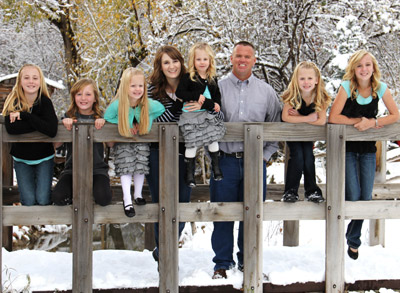Chronic Myeloid Leukemia Survivor
CML survivor enjoying the marathon of life
 Cody Anderson is a roofing and building envelope specialist at Brigham Young University. He also works as a volunteer firefighter and emergency medical technician. He was diagnosed with chronic myeloid leukemia (CML), but he has not let the disease slow him down. He runs, hikes and somehow manages to keep up with his six young daughters. Cody also acts as the Utah State Representative for the National CML Society, and he and his wife facilitate the group’s ground-based support network in the area.
Cody Anderson is a roofing and building envelope specialist at Brigham Young University. He also works as a volunteer firefighter and emergency medical technician. He was diagnosed with chronic myeloid leukemia (CML), but he has not let the disease slow him down. He runs, hikes and somehow manages to keep up with his six young daughters. Cody also acts as the Utah State Representative for the National CML Society, and he and his wife facilitate the group’s ground-based support network in the area.
An avid runner, I had three marathons under my belt before I was diagnosed with CML on March 20, 2009. My wife and I had been married for 10 years and we had five daughters, all under the age of 10. I, myself, was just 33 years old.
I had been feeling sick for several months before I finally went to see a doctor. He performed a blood test and determined that my white blood cell count was 300,000—the normal range is somewhere between 4,500 and 10,000. I was then sent to a cancer treatment center where I was diagnosed with CML.
After I learned about my diagnosis, I was scared. I didn’t know much about the disease because CML is so rare, with only about 6,000 cases each year in the United States and more than half of those diagnoses in people 65 and older. Despite my fears, I held myself together fairly well until my dad met me at the hospital. I then became very emotional as I told him that I didn’t know how I was going to continue to take care of my family. My wife and my daughters needed my support, so I asked my dad to confirm that my life insurance was paid. He immediately told me not to worry about anything and to just focus on getting better.
When the initial fear wore off, I grew determined to beat my cancer. I spent a large amount of time online, self-educating about CML. The National CML Society was an incredibly helpful resource, so much so that I now actively volunteer for the group. I also found Facebook to be a great way to connect with other CML patients. I live in a small town, so word of my diagnosis spread quickly. Nonetheless, I felt – and still feel – hesitant to tell new acquaintances about my condition. So having an online community of people who understood exactly what I was going through was comforting.
At every step, I took my doctors’ treatment advice because I had full confidence in their abilities. To this day, I still see the same doctors for my quarterly checkups, which my wife never misses attending with me. I take a tyrosine-kinase inhibitor (TKI) called dasatinib (Sprycel) in pill form once a day. And because CML is a chronic disease, I will be on this medication for the rest of my life. At times, the cost of my treatment can be a burden, but my life and my health are worth it.
I try to stay active, despite the fatigue my treatment causes. Since my diagnosis, I have completed nine more marathons and am training for another. My wife and I also welcomed our sixth daughter into our family, and our girls are now ages 13, 11, 9, 7, 5 and 3. Last summer, I was able to take my 13- and 11-year-old daughters on a nearly 12,000-foot hike up Mount Nebo near our home. It was an amazing experience. My kids help me to stay emotionally strong, and I want to be there for them for a long, long time.
Over these past four years, I have learned that those who are important in my life will never leave my side, and a cancer diagnosis doesn’t mean that life has to stop. My wife is amazing—she makes all the difference in the world. We are fortunate to live close to our parents and siblings, who have all been great as well. I also have come to lean more heavily on my religion and often turn to it for support. I now know that CML is a manageable disease and there are many resources to help along the way. I feel like I am living a mostly normal life, and I feel like I will live to be a very old man.


